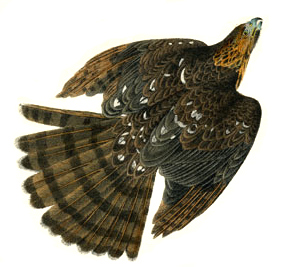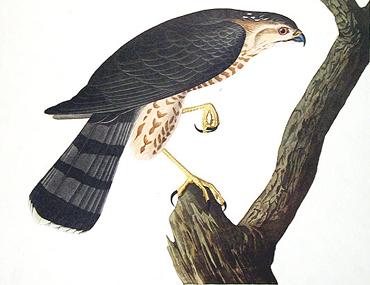 Identity theft is a serious crime. Birds, to my knowledge, rarely bring legal action against one another, but if they did, there is a serious suit brewing amongst the accipiters. Presenting the case of Cooper v. Sharpie!
Identity theft is a serious crime. Birds, to my knowledge, rarely bring legal action against one another, but if they did, there is a serious suit brewing amongst the accipiters. Presenting the case of Cooper v. Sharpie!
Sharp-shinned Hawks and Cooper’s Hawks are so alike as to be nearly indistinguishable. These two birds are a fantastic model of parallel evolution. They look the same, follow similar routines, work similar territories, and migrate at the same times. Some expert birders may be able to peg them with reasonable accuracy but hardly any would claim to be right every time.
The similarities of adult Cooper’s and Sharp-shinned Hawks (immatures are equally difficult to differentiate) start with their plumage, dark gray above with rusty streaks below. Both birds boast piercing red eyes and small hooked beaks. They also sport broadly banded grey and black tails. This last mark helps distinguish them from other raptors, as do their distinctive silhouettes. Hawks of the genus Accipiter are characterized by short wings and long tails. Accipiters have rounded wings, whereas falcons have pointed ones. Buteos like Red-tailed, Red-shouldered, and Rough-legged Hawks also have rounded wings but theirs are longer. As far as other raptors go, you’d be hard-pressed to mistake an accipiter for a vulture or an eagle.
Coopers and sharpies can be distinguished in the field, but observers cannot count on one single mark to make the call. Instead, a holistic approach to identification is required. The best place to start is size. Sharp-shinned Hawks are, for the most part, noticeably smaller than their cousins. Averaging 10-14 inches long, they are comparable in size to a Mourning Dove or Blue Jay. Cooper’s are roughly crow-sized, a hefty 14-20 inches long. Usually, size alone is enough to call a bird with confidence. However, as you can see, the upper range of one bird overlaps with the lower range of the other. In those instances where ambiguity exists, look more closely at the bird’s silhouette.
 The tail is often a giveaway as to an accipiter’s identity. The Cooper’s has a rounded tail, proportionally longer than the Sharp-shinned, with long middle tail feathers and a broad white band at the tip. I’ve heard the sharpie’s tail likened to a matchstick, long, thin, and squared at the end. Its tail is capped by thin white terminal band which may, next to an adjacent grey band, seem like the broader Cooper’s band.
The tail is often a giveaway as to an accipiter’s identity. The Cooper’s has a rounded tail, proportionally longer than the Sharp-shinned, with long middle tail feathers and a broad white band at the tip. I’ve heard the sharpie’s tail likened to a matchstick, long, thin, and squared at the end. Its tail is capped by thin white terminal band which may, next to an adjacent grey band, seem like the broader Cooper’s band.
The Cooper’s is a meatier bird than the sharpie, with a noticeably larger head extending far beyond the wings in flight. Both raptors have broad shoulders but the Cooper’s is thicker throughout. The Sharp-shinned has narrower hips, thinner legs, and a higher apparent center of gravity. Of course, keeping all of these details straight while watching a soaring hawk is a tough task, complicated by the fact that the act of flight changes a bird’s shape. Your last chance for a clean call is to observe the flight style. Cooper’s Hawks follow short glides with slow, regular wingbeats. A sharpie’s flight is both more frenetic and erratic.
With so many details to remember, it is understandable that many birders are intimidated by this accipitrine affinity. As in all matters, practice makes perfect. Once you’ve got a few hawkwatches under your belt, you’ll probably be picking these two birds out with the best of them. Until that day, do what I do and try to stand as close to the best birders possible. Birding tends to be easier that way.













“Usually, size alone is enough to call a bird with confidence.”
I disagree.
1. Female Sharpies and male Coops can be the same size, or pretty close to it. This is not a just corner case. It’s a serious problem.
2. Absolute size is often impossible to judge accurately under field conditions. If the bird is in the sky, alone, with no reference, you cannot tell how big it is. If it is perched in distant vegetation, and you’ve got your scope cranked up to 40x, you cannot tell how big it is. If it erupts unexpectedly out of the trees in front of you, and adrenaline courses through your system (“Accipiter!!”), you cannot tell how big it is (it will look “huge!”).
Perceptions of size are very, very dangerous and lead to many misidentifications (and not only with accipiters).
Thanks, Mike, for the review. But I think it will still take me a while before I can actually distinguish the difference between these two birds. But, practice makes perfect, as many say. I don’t see these two birds often enough; I wish I did. But then, I also don’t get to see a lot of gulls and sparrows, etc. in my daily life which I still am challenged with identifying them. Yet the more we practice, the better we will get. 🙂
One item I like to look for is what is the hawk trying to catch. Sharpies go for smaller birds (being the smaller hawk) like Juncos and House Sparrows up to about the Size of Starling (although I once watched a sharpie get a Gray Squirrel, it couldn’t even lift it off the ground). Cooper’s Hawk prefer Pigeons, Mourning Doves and I’ve seen them go after waterfowl, shorebirds and even Crows. They will regularly chase Gray Squirrels as well, I generally dont’ see them chase anything smaller than a Blackbird/Starling/Robin sized bird.
I personally don’t see the big difficulty in ID’ing these two species. It just takes lots of practice. It also helps to understand the two species in your local area. For example in Upstate New York, Cooper’s Hawk is more likely to be seen in an urban enivironment and is much more likely to be found terrorizing your bird feeder in winter. Sharpies are more migratory and thus there are fewer of them around. Cooper’s Hawks I think are drawn to cities because of their large Pigeon and Starling populations, while Sharpies who like smallers birds stay in more rural areas.
Best adivce I can give? Go to a hawk watch and watch a few thousand of each go over. Then you will have a pretty good idea.
David, I appreciate how you underscore how difficult it is to assess absolute size in the field. However, there are definitely cases where one can differentiate the accipiter based on size, particularly when one is looking at a small sharpie or a large Cooper’s. Anyway, I wouldn’t exactly call attempting to call a bird by size dangerous… this is birding, not brain surgery. I’d rather make an error every once in a while than shy away from learning through experience.
Mary, you’ve got it right. Practice makes perfect!
Will, very nice points. I’ve been impressed by how accurately you’ve been able to differentiate distant accipiters.
The best identifications for me have been with a “sound confirmation”. This year we had a nesting Cooper’s Hawk a few houses down from us so it was nice to get many observations of the one species.
They are so incredibly hard to distinguish that I usually just yell out, “Oh look! It’s a (mumble mumble) hawk!” 🙂
Seriously though, even with the many observations of the Cooper’s Hawk I still have a really hard time with the two.
Great birding to you and great post!
I wish my problem was misidentifying coopers and sharpies. Whenever I got out looking for hawks, I end up with multiple red-tailed hawks and american kestrels. I never see any other hawks (we have plenty of bald eagles, though).
But a great post. This winter I’m going to make a concerted effort to photograph some coopers and sharpies and I’ll have this post bookmarked to help me ID them later.
Hello, we had a raptor land right beside my daughter and myself in our yard. We live in the country with many starlings. This fellow had a starling in his feet squawking away. I got the video camera and got some really good footage. But am having a hard time finding out what kind of raptor this is. Here is the link to the video I uploaded to youtube. This was in March 08, Southwestern Virginia.
http://youtube.com/watch?v=dS6JF8odz8A
Thanks!
Liz
Thank you Mike for referring me to this post! It is indeed so very difficult to make the call as to Coopers or Sharp-shinned. Your post will be a reference recourse the next time I am faced with the dilemma of which is which?
Thank you for your comments on my post of a recent sighting.
ann
Just witnessed an adult Cooper’s Hawk watching over at least three others as they fed in the wooded area behind my house. Only got one clear photo of the back of the adult. The other 2, shot through my kitchen window, show two other large young or other adults on a branch but did not catch the one of the ground. Today is July 10, 2011 and I live in Fort Worth about five miles from downtown – very urban.